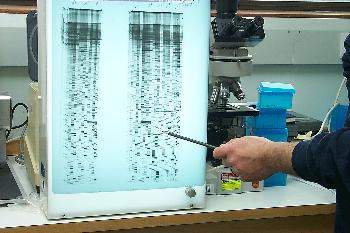
| |
|
|
 |
|
|
The role of the Institute for Animal Health in the current outbreak of Foot-and-Mouth Disease in the UK 27th February 2001: The Institute for Animal Health (IAH) is an international centre for research into the major infectious diseases of farm animals. It is sponsored and funded by the Biotechnology & Biological Sciences Research Council (BBSRC) and undertakes research in support of the policies of the Ministry of Agriculture, Fisheries and Food (MAFF) to control animal disease. The IAH’s Pirbright Laboratory was first alerted to a suspected case of foot-and-mouth disease (FMD) on Monday 19th February and subsequently confirmed this diagnosis. Since then the IAH has been actively working with MAFF in its investigation of the source and extent of the FMD outbreak. The role of the IAH in the current outbreak of FMD is to support the on-farm activities of MAFF by providing a laboratory diagnostic service for establishing the foot-and-mouth disease status of samples taken from animals suspected of being infected.  The genetic sequencing of the Foot-and-Mouth virus by scientists at the IAH When tissue and blood samples are received at the laboratory, tests to identify the presence of virus are set up. If large quantities of virus are present these tests can yield a positive result within 4 hours. In some cases it may be necessary to multiply the virus by infecting cells in culture, in this case it can take up to 4 days to be sure there is no virus present in the samples. Virus grown in this way can be used to provide genetic material for sequencing for very precise identification of the type and strain of virus. Blood samples can be used to look for signs of past infection even though infectious virus may not be present. Following the confirmation of FMD in a number of farms across England, the Institute is now testing several hundred samples to determine the extent and spread of the disease. Scientists from the Pirbright Laboratory are also providing MAFF with technical advice, by assessing the risk to surrounding areas and the nearby continent due to wind-borne spread of the virus. They are working in collaboration with both the UK Meteorological Office and the Danish Meteorological Institute. Additionally, the IAH is collaborating with MAFF in an attempt to trace the source of the current outbreak, which IAH identified as being type O, PanAsia strain. This strain first appeared in India in 1990 and the Institute has monitored its geographic spread over the last 10 years. Although the strain was the cause of a number of outbreaks in different countries during 2000, the source of the current FMD outbreak in the UK has still to be determined. The IAH has specialised knowledge of FMD, with its Pirbright Laboratory being an international reference centre for this disease, providing emergency diagnostic services 24 hours a day, 365 days a year. The IAH Pirbright Laboratory also houses an International Vaccine Bank, with 0.5 million doses of each of seven strains of FMD. The UK has never vaccinated against FMD but this reserve of concentrated inactivated antigens is held in case a decision was taken by the UK, or any of the other 7 members of the bank faced with an emergency, to use ring vaccination as an adjunct to the traditional and well tested "stamping out" policy. Stamping out means the slaughter and disposal of all affected and in-contact susceptible animals on a premise, followed by the disposal of the carcasses by burial or burning. The premise is then thoroughly disinfected. Movement stand-still in the surrounding area, i.e. a period of quarantine, is an important element of the control procedures. In addition to maintaining an emergency service for responding to outbreaks of FMD, the IAH also has an ongoing research programme to gain a better understanding of the pathogenesis and epidemiology of this devastating disease in order to provide improved methods of diagnosis and control. Further information on Foot-and-Mouth Disease can be found on the web site of the IAH on www.iah.bbsrc.ac.uk/pid and information on the FMD virus (picornaviridae) with news of the current outbreak on www.iah.bbsrc.ac.uk/virus. |
|
|
Copyright 1994 to 2024 Equiworld at Hayfield, Aberdeen, Scotland - 30 years on the web. Archived Version.